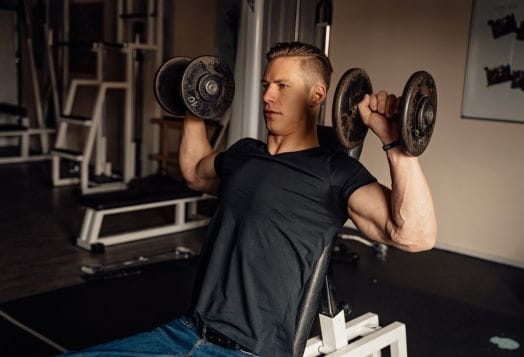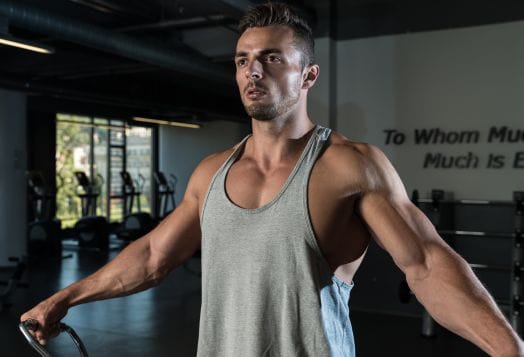Tired of shoulders that crack louder than your morning cereal? It’s time to fix that. Strong, stable shoulders aren’t just for show, but they’re key to lifting better, moving safer, and avoiding those “ouch” moments. During gym day, the right shoulder workouts can make all the difference. Here’s how to strengthen them smartly with the best shoulder exercises.
What Are Shoulder Workouts?

Shoulder workouts are exercises that not only make you look good in a T-shirt (though that’s a nice bonus) but also target your deltoids, rotator cuff, and upper body support crew, including your trapezius and glenohumeral joint.
This shoulder routine builds upper body strength, improving shoulder stability and performance. Whether it's a dumbbell shoulder workout, resistance training, or classic shoulder exercises, these moves help you press stronger, move better, and prevent injuries.
Muscles Worked in Shoulder Workouts
Shoulder workouts target the three key deltoid muscles: the anterior, lateral, and posterior deltoids. These muscles are the stars of your shoulder day exercises, helping with pressing, lifting, and overall shoulder strength. But the work doesn’t stop there because shoulder training also hits your trapezius, rotator cuff muscles (like the supraspinatus and infraspinatus), and serratus anterior.
Plus, by isolating these muscles, you’ll also get upper chest, triceps, and upper back activation. So, whether you're aiming for muscle hypertrophy or simply the best shoulder exercises for strength, your shoulders are working overtime.
How to Perform a Shoulder Workout (Step-by-Step)

Building strong, stable shoulders isn’t about just throwing weights around. It’s about warming up well, training smart, and finishing with a solid cool-down. Here's your full shoulder workout game plan, combining pressing power, shoulder stability, and upper body strength.
Step 1: Warm-up and mobility
Before we lift heavy, we warm up like champs. Think of it as prepping your shoulder joints to show off their best moves.
Arm Circles: Stretch your arms out like an aeroplane and start making small, controlled circles. Gradually make them bigger and watch how your deltoids thank you. Do 10 in each direction.
Band Pull-Aparts: Grab a resistance band and show it who's boss. Pull it apart at chest height, squeezing your shoulder blades together for perfect posture power.
Scapular Push-Ups: In plank position, keep arms straight and only move the shoulder blades in and out. Do two sets of 10.
Step 2: Dumbbell shoulder workout
For building a balanced upper body, don’t miss the benefits of the bench press. Now that you’re warmed up, it’s time to pick up those dumbbells and give your delts a real reason to grow.
Dumbbell Shoulder Press (3x10): Sit or stand with dumbbells at shoulder height, palms facing forward. Press overhead until arms are straight, then slowly lower. Engage your rotator cuff and avoid arching your back.
Dumbbell Lateral Raises (3x12): Hold dumbbells at your sides, then raise arms out to shoulder level with a slight bend in the elbow. Control the descent to maximise shoulder stability.
Dumbbell Front Raises (3x12): Hold the dumbbells in front of your thighs and raise them straight up to shoulder height. Keep your core tight and avoid swinging.
Step 3: Compound movements
Time to lift like a legend, these big moves build serious upper body strength.
Overhead Barbell Press: Stand with feet shoulder-width apart. Press a barbell from shoulder level straight overhead. Keep your spine neutral and elbows slightly forward at the bottom.
Arnold Press: Start seated with dumbbells in front of you, palms facing in. Rotate your wrists out as you press the weights overhead. This move targets the front and side delts in one smooth motion.
Step 4: Stability-focused exercises
Strong muscles are great, but stable muscles are unbeatable. Here’s where you bulletproof your shoulders
Single-Arm Landmine Press: Anchor one end of a barbell into a landmine or corner. Holding the other end with one hand, press forward and up. Great for shoulder strength and coordination.
Resistance Band Face Pulls: Attach a band at upper chest height. Pull towards your face, elbows high, squeezing the shoulder blades. Ideal for posture correction and rotator cuff strength.
Step 5: Cool down and stretch
You crushed your shoulder workout, and now give those hardworking muscles the love they deserve.
Cross-Body Arm Stretch: Pull one arm across your chest and hold with the opposite hand.
Doorway Stretch: Place your hands on either side of a doorway and gently lean forward to open up the chest and shoulders.
Common Mistakes to Avoid in Shoulder Workouts

Even the best shoulder workouts can go sideways if form, balance, and variety take a backseat. Let’s tackle the usual suspects and how to fix them.
1. Using excess weight
Going too heavy too soon compromises your form and puts unnecessary strain on your shoulder joints, increasing the risk of overuse injury.
The Fix: Scale back the weight and focus on clean, controlled movements. Prioritise good gym form tips over ego-lifting.
2. Neglecting rear delts
Most shoulder day exercises hit the front and side delts, leaving the rear delts undertrained. This leads to muscular imbalance and poor posture.
The Fix: Add face pulls, reverse flyes, or bent-over rear delt raises to your shoulder routine to target these often-ignored muscles.
3. Shrugging during lifts
If you are struggling with tight shoulders, Try these chest stretches to improve shoulder mobility. Letting your traps take over by shrugging during overhead presses limits delt activation and can cause scapular instability.
The Fix: Keep your shoulders down and away from your ears. Engage your core and focus on pressing through the deltoids without lifting your traps.
4. Lack of stable movements
Skipping stability exercises leaves your rotator cuff weak and your glenohumeral joint unsupported, creating prime conditions for injury.
The Fix: Incorporate movements like resistance band face pulls and single-arm landmine presses. They strengthen stabilisers and improve shoulder joint safety.
Tips to Get the Most Out of Your Shoulder Workouts
Dialling in your shoulder workouts isn’t just about lifting heavier, but it’s about lifting smarter. These science-backed strategies can take your deltoid gains from decent to dynamic.
1. Use progressive overload
Don’t let your shoulders get too comfortable. Gradually increase resistance or reps to push your muscles to adapt. This is a tried-and-tested muscle growth strategy that’s especially effective in a dumbbell shoulder workout setup.
2. Train your shoulders twice a week
Once a week won’t cut it. For real results, split your sessions across strength-building and mobility-focused shoulder exercises. This balance supports shoulder training frequency and long-term joint health.
3. Focus on the mind-muscle connection
For expert guidance and personalised coaching, explore our fitness trainer options. Going through the motions doesn’t build shoulders. Think about each rep—activate your delts intentionally instead of just moving weight. That neuromuscular connection boosts deltoid fibre recruitment and overall effectiveness.
4. Add tempo training to the mix
Control is strength. Slowing down the eccentric phase (the lowering part) of lifts like the dumbbell shoulder press increases tension and promotes hypertrophy. Tempo training is a subtle but powerful advanced lifting technique.
Build Strong Shoulders That Last
Mastering your shoulder workouts isn’t just about heavy lifts, but it’s about intention. Focus on proper form, deltoid sculpting, and balanced development for long-term joint health and upper body conditioning.
Priorities functional strength, smart programming, and stability work to keep your movements safe and powerful. Start integrating these shoulder workouts into your gym days and build a powerful upper body with confidence and control.




